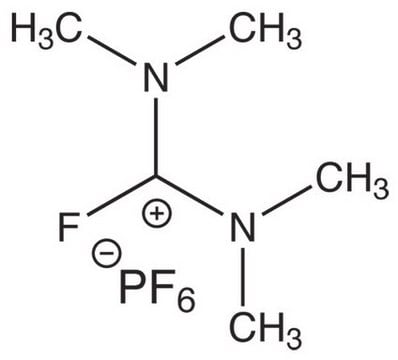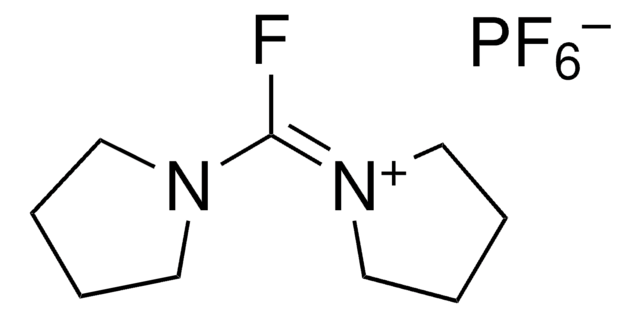77386
2-Bromo-1-ethyl-pyridinium tetrafluoroborate
≥97.0% (T)
Sinónimos:
BEP
Iniciar sesiónpara Ver la Fijación de precios por contrato y de la organización
About This Item
Fórmula empírica (notación de Hill):
C7H9BBrF4N
Número de CAS:
Peso molecular:
273.86
Beilstein:
4059265
Número CE:
Número MDL:
Código UNSPSC:
12352005
ID de la sustancia en PubChem:
NACRES:
NA.22
Productos recomendados
Ensayo
≥97.0% (T)
Formulario
crystals
idoneidad de la reacción
reaction type: Coupling Reactions
mp
103-107 °C
aplicaciones
peptide synthesis
grupo funcional
bromo
cadena SMILES
F[B-](F)(F)F.CC[n+]1ccccc1Br
InChI
1S/C7H9BrN.BF4/c1-2-9-6-4-3-5-7(9)8;2-1(3,4)5/h3-6H,2H2,1H3;/q+1;-1
Clave InChI
YJDXVQLBIAJTHP-UHFFFAOYSA-N
Descripción general
2-Bromo-1-ethyl-pyridinium tetrafluoroborate is a coupling reagent employed in the synthesis of amides and esters through amidation and esterification reactions, respectively. It is generally prepared by the reaction of triethyloxonium tetrafluoroborate with 2?bromo pyridine.
Aplicación
2-Bromo-1-ethyl-pyridinium tetrafluoroborate can be used as a coupling reagent for:
- The synthesis of N-methylated peptides in solution and solid phase.
- The synthesis of cyclosporin A fragment and dolastatin 15 pentapeptide moiety.
Otras notas
Coupling reagent for peptide synthesis; less racemization and faster reaction than with other reagents;e.g. BOP, PyBrOP, PyClU, BTFFH, CMBI
Código de clase de almacenamiento
11 - Combustible Solids
Clase de riesgo para el agua (WGK)
WGK 3
Punto de inflamabilidad (°F)
Not applicable
Punto de inflamabilidad (°C)
Not applicable
Equipo de protección personal
Eyeshields, Gloves, type N95 (US)
Elija entre una de las versiones más recientes:
¿Ya tiene este producto?
Encuentre la documentación para los productos que ha comprado recientemente en la Biblioteca de documentos.
Los clientes también vieron
Julien Lupo et al.
AIDS (London, England), 33(6), 993-1000 (2019-04-05)
Epstein-Barr virus (EBV) has been implicated in lymphomagenesis of HIV-related classical Hodgkin lymphoma (HIV-cHL). The utility of EBV molecular and serological biomarkers has scarcely been examined in HIV-cHL in the recent combined antiretroviral therapy (cART) era. We evaluated EBV DNA
Benjamin J Burwitz et al.
Nature communications, 8(1), 2146-2146 (2017-12-17)
Hepatitis B virus (HBV) is a major global health concern, and the development of curative therapeutics is urgently needed. Such efforts are impeded by the lack of a physiologically relevant, pre-clinical animal model of HBV infection. Here, we report that
Ya-Ling Chou et al.
Journal of the Chinese Medical Association : JCMA, 82(6), 510-514 (2019-06-11)
Congenital TORCH (toxoplasmosis, other viruses [varicella-zoster virus, VZV, etc.], rubella, cytomegalovirus [CMV], Herpes simplex virus [HSV]) infections are major causes of prenatal, perinatal, and postnatal morbidity and mortality. Although treatment or prevention strategies are available for these pathogens, all drugs
Benjamin Gille et al.
SLAS technology, 23(2), 188-197 (2018-01-19)
The lack of (inter-)laboratory standardization has hampered the application of universal cutoff values for Alzheimer's disease (AD) cerebrospinal fluid (CSF) biomarkers and their transfer to general clinical practice. The automation of the AD biomarker immunoassays is suggested to generate more
Shigeo Horinaka et al.
British journal of clinical pharmacology, 84(1), 79-87 (2017-09-10)
The aim of the present study was to demonstrate evidence of reduced thrombin generation at the trough plasma rivaroxaban concentration. A single-centre, prospective, nonrandomized, drug-intervention, self-controlled study was conducted in 51 anticoagulation therapy-naïve patients with nonvalvular atrial fibrillation. Plasma rivaroxaban
Nuestro equipo de científicos tiene experiencia en todas las áreas de investigación: Ciencias de la vida, Ciencia de los materiales, Síntesis química, Cromatografía, Analítica y muchas otras.
Póngase en contacto con el Servicio técnico









